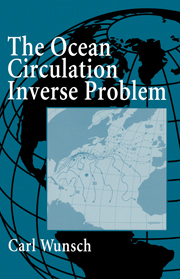6 - The Time-Dependent Inverse Problem
Published online by Cambridge University Press: 07 May 2010
Summary
The discussion so far has treated the ocean circulation as though it were steady-apart from concerns about aliasing from components regarded mainly as noise. But one does not really expect a fluid system as complex as the coupled ocean and atmosphere, driven externally by the sun, to remain steady. Indeed, if there were certain elements, describable as a finite band of frequencies and/or wavenumbers, which were truly steady, it would be both a remarkable phenomenon and a very powerful theoretical tool. For this would be a statement that a spectral gap existed, permitting the separation of the flow field into different dynamical regimes, as sometimes assumed in turbulence theories (e.g., Monin & Yaglom, 1975).
Treatment of the ocean circulation as though it were time invariant carries the weight of history and tradition, and there is no doubt that a great deal has been learned about the ocean this way. But as oceanographers become more quantitative in their description of the circulation, it must be recognized that the steadiness assumption has been a consequence of necessity dictated by the paucity of data and intellectual inertia rather than a defensible deduction from fluid dynamics. One must question whether a steady, laminar flow field (as in Figures 2–7, 2–29) could conceivably depict the physics of a fluid that is turbulent in the sense suggested by Figure 1–1.
- Type
- Chapter
- Information
- The Ocean Circulation Inverse Problem , pp. 324 - 404Publisher: Cambridge University PressPrint publication year: 1996



